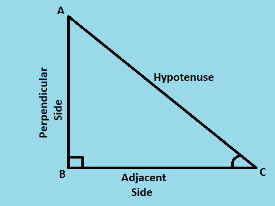Trigonometric Ratios
Trigonometry is a branch of mathematics that deals with the relationship between the angles and sides of a right triangle. This step-by-step guide teaches you trigonometric ratios.

Related Topics
A step-by-step guide to trigonometric ratios
Trigonometric ratios are the ratio of the lengths of the sides of a triangle. These ratios in trigonometry relate the ratio of the sides of a right triangle to the corresponding angle. There are six trigonometric ratios, namely, sine, cosine, tangent, secant, cosecant, and cotangent. These ratios are written as \(sin\), \(cos\), \(tan\), \(sec\), \(cosec\) (or \(csc\)), and \(cot\) in short.
The values of these trigonometric ratios can be calculated using the measurement of an acute angle, \(θ\), in a right triangle.

What are trigonometric ratios?
These six trigonometric ratios can be defined as:
Sine: In the given triangle, the \(sin\) of the angle \(θ\) can be considered as follows, \(\color{blue}{sin\: θ = \frac{AB}{AC}}\).
Cosine: In the given triangle, the \(cos\) of the angle \(θ\) can be considered as follows, \(\color{blue}{cos\: θ = \frac{BC}{AC}}\).
Tangent: In the given triangle, the \(tan\) of the angle \(θ\) can be considered as follows, \(\color{blue}{tan\: θ = \frac{AB}{BC}}\).
Cosecant: In the given triangle, the \(cosec\) of the angle \(θ\) can be considered as follows, \(\color{blue}{cosec\: θ = \frac{AC}{AB}}\).
Secant: In the given triangle, the \(sec\) of the angle \(θ\) can be considered as follows, \(\color{blue}{sec\: θ = \frac{AC}{BC}}\).
Cotangent: In the given triangle, the \(cot\) of the angle \(θ\) can be considered as follows, \(\color{blue}{cot\: θ = \frac{BC}{AB}}\).
Trigonometric ratios formulas
We can use the shorthand form of trigonometric ratios to compare the length of both sides with the base angle. The angle \(θ\) is acute \((θ<90º)\) and in general is measured with reference to the positive \(x\)-axis, in the anticlockwise direction. The basic trigonometric ratio formulas are given below,
- \(\color{blue}{sin\: θ = \frac{Perpendicular}{Hypotenuse}}\)
- \(\color{blue}{cos\: θ = \frac{Base}{Hypotenuse}}\)
- \(\color{blue}{tan\: θ = \frac{Perpendicular}{Base}}\)
- \(\color{blue}{sec\: θ =\frac{Hypotenuse}{Base}}\)
- \(\color{blue}{cosec\: θ = \frac{Hypotenuse}{Perpendicular}}\)
- \(\color{blue}{cot\: θ = \frac{Base}{Perpendicular}}\)
Trigonometric Ratios – Example 1:
Find the value of \(tan\:θ\) if \(sin\:θ\:=\frac{10}{3}\) and \(cos\:θ\:=\frac{5}{3}\:\).
Solution: Use the formula of the trigonometric ratio to solve this problem: \(tan\: θ = \frac{Perpendicular}{Base}\).
\(tan\:θ =\frac {10}{5}=2\)
Related to This Article
More math articles
- Why Do Most Students Struggle with Math?
- Convert Rational Numbers to a Fraction
- TExES Core Subjects Math Formulas
- The Ultimate 7th Grade PEAKS Math Course (+FREE Worksheets)
- 4th Grade IAR Math Practice Test Questions
- How to Understand Vectors: Vectors in Two Dimensions
- How to Solve Prime Factorization with Exponents?
- 5th Grade NYSE Math FREE Sample Practice Questions
- The Best Calculator for the SAT or ACT
- Calculus: Navigating the Pathways of Particles





















What people say about "Trigonometric Ratios - Effortless Math: We Help Students Learn to LOVE Mathematics"?
No one replied yet.